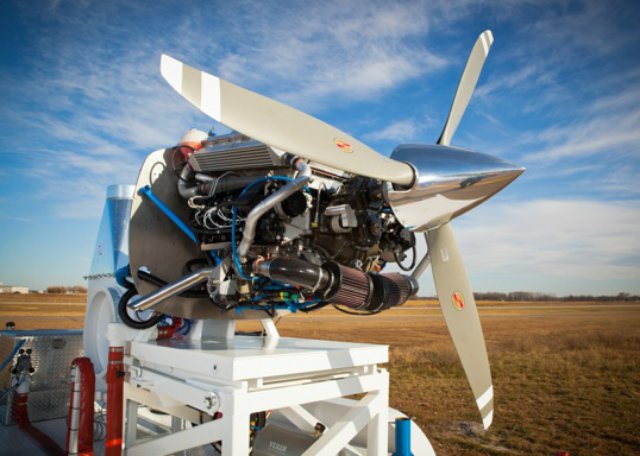 Engineered Propulsion Systems (EPS), Inc., of New Richmond, Wisconsin, has validated its innovative 4.4-liter, “Flat-Vee” Vision 350 weight-competitive aero-diesel engine design for General Aviation (GA) and military Unmanned Aircraft Systems (UAS) markets, following extensive testing at Hartzell Propeller headquarters in Piqua, Ohio.
Engineered Propulsion Systems (EPS), Inc., of New Richmond, Wisconsin, has validated its innovative 4.4-liter, “Flat-Vee” Vision 350 weight-competitive aero-diesel engine design for General Aviation (GA) and military Unmanned Aircraft Systems (UAS) markets, following extensive testing at Hartzell Propeller headquarters in Piqua, Ohio.
Hartzell found the EPS engine fully capable of achieving propeller durability on traditional aluminum, ASC-II composite blades, and also on Hartzell’s new composite graphite Bantam 5-bladed propeller at power levels exceeding 350 hp. The testing proved that Hartzell’s array of propeller blades are all adaptable to the EPS engine, without the need for further engine vibration dampers.
EPS created the Vision 350 engine with several innovative features, including the design and integration of vibration counter-measures, rather than an add-on friction-based, spring, or clutch elements to control vibration like some attempts in the aero-diesel market. As such, the Vision 350 is smoother running than any diesel engine and many current gasoline GA engines tested.
Other features of the new EPS engine include FADEC electronics, ease of retrofit to many in-production aircraft types, integrated liquid cooling, a fuel-driven engine pre-heater that warms the water jacket fluid, and a compact “Flat Vee” 8-cylinder, 4-stroke diesel configuration. The company hopes to earn an initial TBO greater than 2,000 hours. FAR 33 status is the basis of the certification application to the FAA.
EPS chief technical officer (CTO), Steven Weinzierl, said, “This engineering milestone, completed in collaboration with Hartzell, is a significant step forward in bringing our diesel engine to market. When we began this project, we knew that designing a high performance diesel to work reliably with propeller and gear reduction systems would be a technical challenge.
“It’s a distinct departure from prior engine designs, and we believe what Hartzell has now confirmed: induced vibration is no longer an issue.”
Hartzell Propeller Vice-President of Engineering, Bruce Hanke, said, “Hartzell was eager to work closely with EPS to perform stress surveys on three different propeller types, including one with aluminum blades, to gain an understanding of the compatibility of the engine to our propellers. We were very encouraged to see that the stresses on the propellers were acceptable and lower than most engines we have surveyed.
“We look forward to continuing to work with EPS on this innovative new product” he added.
The Vision 350’s targeted wet running weight is 298 kg (657 lb). While 30-50 lb heavier than a gasoline engine installation of similar power (example: Continental TSIO 550 and Lycoming TIO540), that penalty is easily offset by its fuel efficiency. The engine will take Jet A, JP-8 or diesel fuel.
Source: Press Release

I would like to get on your email newsletter list for updates…Went do you expect to have it available for General aviation Jake Beiler
Jake, I suggest that you contact EPS directly – click on their name in the article to link to their web-site….